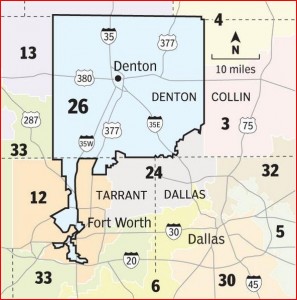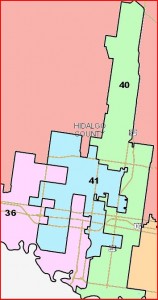The redistricting lawsuit in San Antonio wrapped up on Friday, so at this point all we can do is wait for the three-judge panel to issue its opinion, and for the DC Circuit Court to have it say on preclearance. You never know what judges will do, but there may be some tea leaves to be read from the way final arguments went.
The state’s lead attorney, David Schenck, said the redistricting lawsuits are an “effort to fix the results of an election,” comparing it to what happened in Chicago in the 1920s and claiming that the plaintiffs were attempting to turn the Voting Rights Act into a “quota program for redistricting.”
Unlike the plaintiffs, who used their closing statements Thursday to reiterate their objections to the state’s redistricting maps, the state’s attorneys came under aggressive questioning from the panel of three federal judges presiding over the trial.
Judge Xavier Rodriguez, a former judge on the Texas Supreme Court who was appointed to the federal bench by President George W. Bush, repeatedly questioned Schenck, asking if the state felt compelled to apportion the four new congressional districts to reflect the fact that most of the state’s population increase came from minority populations.
Schenck denied that the state had any such obligation. Ninety percent of Texas’ massive population growth in the past decade came from minority groups, with Hispanics accounting for 60 percent of the state’s overall gain.
Rodriguez also questioned state lawyer David Mattax about how far the state could go to protect incumbents, pointing out that the redistricting plan created a new district for Rep. Aaron Peña, R-Edinburg, that was significantly different than the district he initially won as a Democrat.
Mattax argued that the state was exercising its prerogative to use “traditional redistricting principles,” including incumbent protection, and that Peña’s seat wasn’t an abuse of the privilege because his new district was in the same county as his old district.
Trial observers have speculated that Rodriguez could be the swing judge on the panel.
Maybe it means something and maybe it doesn’t. I know I’d rather have the judges ask their guys the hard questions and not ours.
The story notes that the state’s own expert witness had said he thought CD23 was wrong, but that wasn’t the only district in dispute. The Statesman gets into that.
Plaintiffs’ lawyer Gerald Hebert has his eye on Congressional District 26 in North Texas. He said the proposed boundaries take a mostly Republican district in Denton County and rope in a strip of largely Democratic Latino precincts of Tarrant County.
The district, which looks like a leaky bucket, would silence the high-turnout Latino precincts in Tarrant County by putting them in an overwhelmingly Republican district in Denton County, Hebert said.
The story sidebar had images of the districts in question. Here’s what CD26 looks like:
You may wonder why there’s what weird, not remotely “compact” extrusion into Tarrant County. The answer can be found in the population analysis for CD26:
County Total White Black Hisp B+H Other ==================================================== Denton 549,832 368,776 45,862 99,341 143,092 37,964 Tarrant 147,815 37,253 9,681 96,331 105,085 5,477
Remember, the state has argued that it could not draw a Latino opportunity Congressional district in the D/FW area because the population was too dispersed to draw a compact district for them. But taking a meandering slice of Tarrant County to stack as many Latinos into CD26 as there are in all of Denton County, with more than three times the population? No problemo.
Plaintiffs’ lawyers also are targeting state House District 41 in Hidalgo County, which is sometimes called the “running man” district because of its shape. The district, which is in a largely Democratic county, was designed to protect Rep. Aaron Peña, R-Edinburg, who switched parties before the 2011 legislative session.
“It was done for political purposes, pure and simple,” said Rick Gray, one of the plaintiffs’ lawyers. “There has been no effort by the state whatsoever to comply with traditional redistricting practices.”
And here’s HD41, which I showed in a previous post:
This is what the GOP had to do to try to save Pena’s worthless ass. I get the “running man” description, but I find it reminiscent of something from an old school video game, perhaps the version of Tetris they play in the ninth circle of hell. Again, don’t draw crap like this and then try to argue non-compactness as a reason to stiff Latino voters.
Like I said, we’ll see what the judges have to say. The longer they take, the more likely they’ll be the ones drawing the replacement maps if there are any. On a related note, since we’re also waiting for the DC Court to render its opinion, here’s what Texas Redistricting says about the issues it will rule on.



Pingback: DOJ pushes back on State House and Congressional maps – Off the Kuff